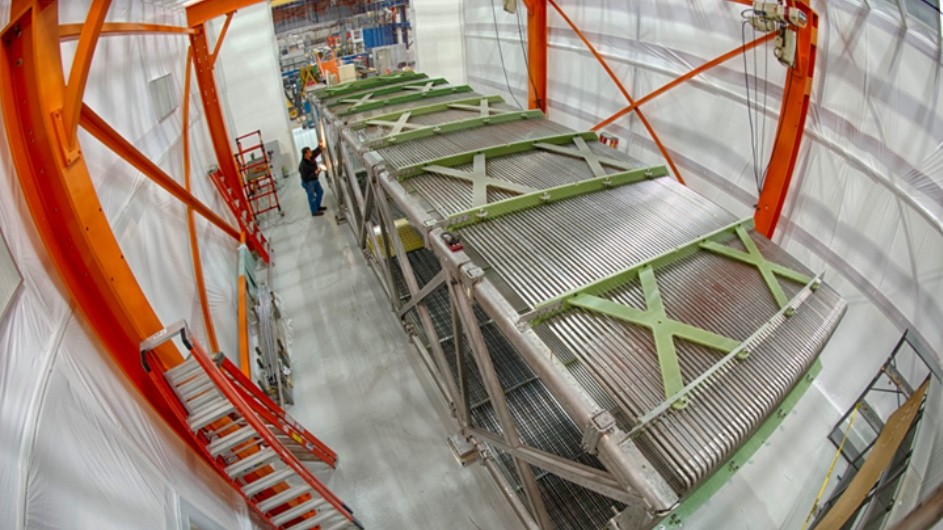A New Clue in a Decades-Long Search for a Fourth Type of Neutrino
The Columbia Neutrino Group co-led the photon analysis of the MicroBooNE neutrino experiment at Fermilab, which announced its results on Oct. 1.

Neutrinos are the most abundant particles with mass in our universe, but they barely interact with matter. Despite this, scientists have established that neutrinos come in three types—electron, muon, and tau—and can morph, or “oscillate,” from one type to another as they travel long distances.
In two experiments dating back to the mid-1990s, researchers uncovered evidence that neutrinos might change form over surprisingly short distances. This anomaly has puzzled neutrino scientists ever since, suggesting that a fourth type of “sterile” neutrino might exist to explain the fast oscillations. Independent confirmation of fast oscillations, and by extension, sterile neutrinos, would represent a major discovery in particle physics, with profound implications for our understanding of nature.
Watch Georgia Karagiorgi in the PBS Nova special
The MicroBooNE neutrino experiment at the U.S. Department of Energy (DOE)'s Fermi National Accelerator Laboratory near Chicago was launched in 2015 to investigate whether the earlier observed signal could be confirmed by a new type of neutrino detector. The goal was to discover whether the signal was made of photons or electrons, which would support the sterile neutrino possibility. The MicroBooNE detector uses a powerful liquid argon time-projection chamber to image neutrino interactions at high resolution to differentiate between neutrino-produced electrons and photons.
Less than 2 hours from now, MicroBooNE will share the results from its blinded search for single photons in a live-streamed Fermilab seminar at 16:00 CDT. Connect here: https://t.co/sbYPJVwcsc pic.twitter.com/oxctwUPG0k
— MicroBooNE (@Microboone) October 1, 2021
A postdoc in the Columbia Neutrino research group, Mark Ross-Lonergan, presented the first results from the photon search on Oct. 1 at a Fermilab Joint Theory-Experimental Seminar. The analysis, led by MicroBooNE collaborators at Columbia and DOE's Los Alamos National Laboratory, included three years of neutrino data with a focus on finding any unusual neutrino-produced photons.
Searching for Ghostly Neutrinos to Understand Why Matter Dominates the Universe
The team found none—at a 95 percent confidence level—thus ruling out this process as the anomaly culprit. "This result is a major step forward in our understanding of neutrinos and their interactions, and the culmination of years of work to develop advanced data reconstruction and selection tools," said Georgia Karagiorgi, an associate physics professor at Columbia and a lead investigator on the project. "It also highlights the capability of the liquid argon technology to accurately differentiate electrons from photons."
“This high level of reconstruction and signal classification is what sets the MicroBooNE measurement apart from prior measurements,” says Kathryn Sutton, GSAS ‘21, who helped lead the single-photon analysis team. “We leveraged machine learning techniques to isolate an extremely subtle signal.”
Ruling out neutrino-produced photons adds an important piece to the puzzle. “But there are multiple other rare processes or other exotic new physics models capable of producing electrons or other electromagnetic activity that we have not yet explored," said Ross-Lonergan. "We’re going after those next!”
MicroBooNE researchers are now working to improve their neutrino event reconstruction and selection tools, and analyze a new round of data. Results of the MicroBooNE electron searches are expected to be released on Oct. 27.
The Columbia Neutrino Group is funded by the U.S. National Science Foundation. The MicroBooNE collaboration includes 178 scientists and engineers from 36 institutions in the United States, Switzerland, United Kingdom, Spain, and Israel. Visit the MicroBooNE website, and follow the experiment on Facebook and Twitter.